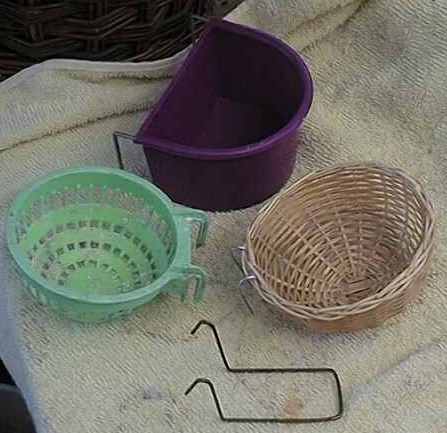

The above picture shows containers which are typically used for nesting Diamond Doves. The purple container is a feed cup which can be gotten at most pet stores. The limitations are endless as to what can be used for nest containers for the DD or other small doves; such as Capes, Passerine Ground, Incas, Pygmy Ground, etc.
The main thing I like to stress to all dove fanciers is to ensure all nest containers are attached securely and remain as horizontal as possible.
EXTRA
NEST SUPPORTS
The wicker canary nest in the picture above has a wire hanger, but I
prefer to replace it with one I make from clothes hangers. It is hot glued to
the bottom of the wicker nest after the prongs are weaved up thru the side (the
prongs or hooks are bent after weaving & hot gluing). This hanger then
supports the nesting bird and keeps the nest from sagging. A sagging nest can
cause the parents to add more nesting materials, piling it above the top edge
possibly covering the eggs. It can also sag enough from the weight of the birds
that the eggs or young can fall or be knocked from the nest.

The above picture shows a Ringneck Dove utilizing a gallon milk container as a nest. A wire hanger is made from a clothes hanger which allows the container to be hung in the corner of the breeder cage. I make two small drain holes in the bottom of these containers so water can be drained if by chance rain gets into the nest.
The half gallon milk containers cut in a similar fashion will also work for the DD set-up in a breeder cage.
I use the half gallon and gallon sizes as feeders for the birds in breeder cages and the walk in flights. You can click on this link FEED CONTAINERS and see a picture of them. use your browser's "back" button to return to this page after viewing the picture.


ŠJohn Pire
The large deep wicker basket
(left) is actually a plant hanger & had rope hangers. I cut off the rope hangers
& attached the basket to the platform. The doves hunker down inside the nest
when they see me - thinking they are out of view. Plus the babies need to be a
few days older to fledge over the edge of the deep basket. The front area allows
the young & parents a place to sit; plus the nest does not receive the full
impact of the bird landing on the basket, most will land on the front & then
step up into the basket.
The green basket & yellow bowl were purchased at the local "dollar" store & work
great.


ŠJohn Pire
The above pictures shows several types of nest platforms in which wicker
baskets or plastic containers can attached to. I attach the wicker baskets &
plastic containers with short roofing nails or
staples. The "box" type can be left as is & filled with hay, etc. Size can vary
of the wooden platforms; 6" square is a standard size to build & will fit most
dove species. I prefer to have the sides at least 2" or more high to help keep
the nesting materials in. The box type is an old parakeet box, with the top &
half the front removed.
Do not use any type of fastener that leaves a raised head. Eggs can be
cracked/punctured by it.
The pictures below show plastic feed/seed bowl that can also substitute for a nest container. They can be filled with nesting materials. They are slick sided & the hay, twigs etc can be pushed from inside - leaving no materials for the eggs or young. The metal hangers are used to hang the bowl on the wire sides & can be easily made by anyone who can weld or at your local metal shop.


ŠJohn Pire
Typical feed dishes sold in pet stores;
this style is number CS3